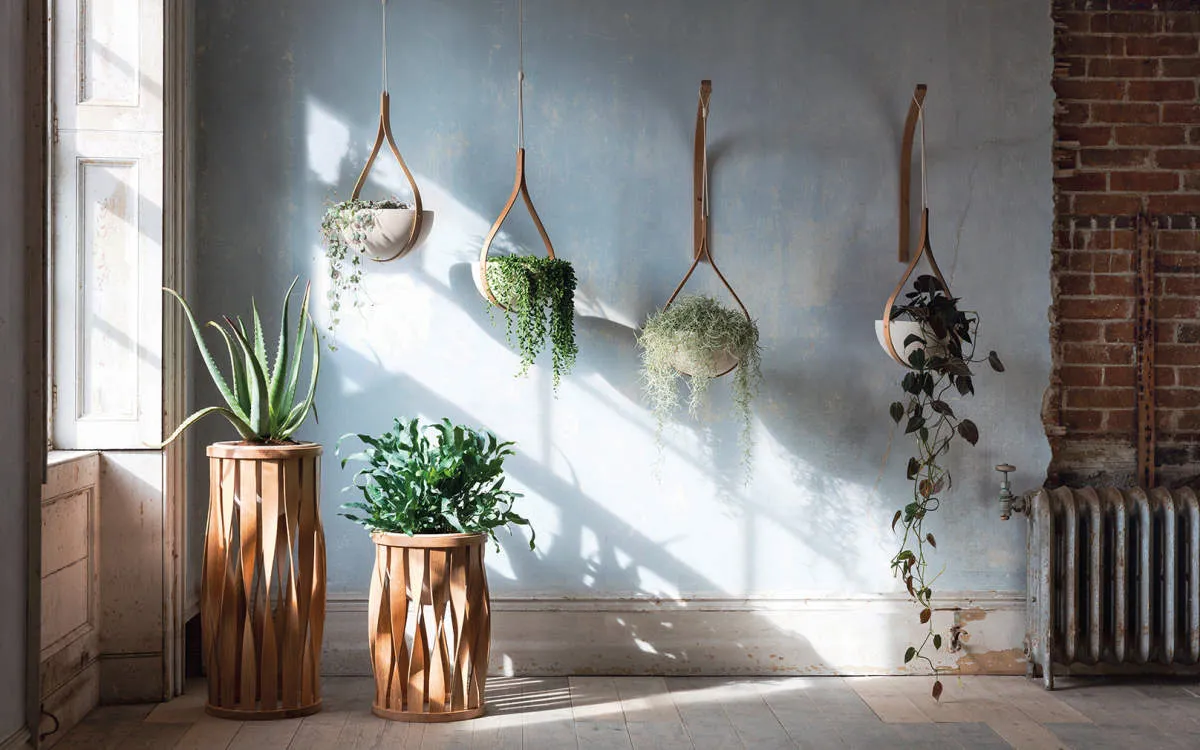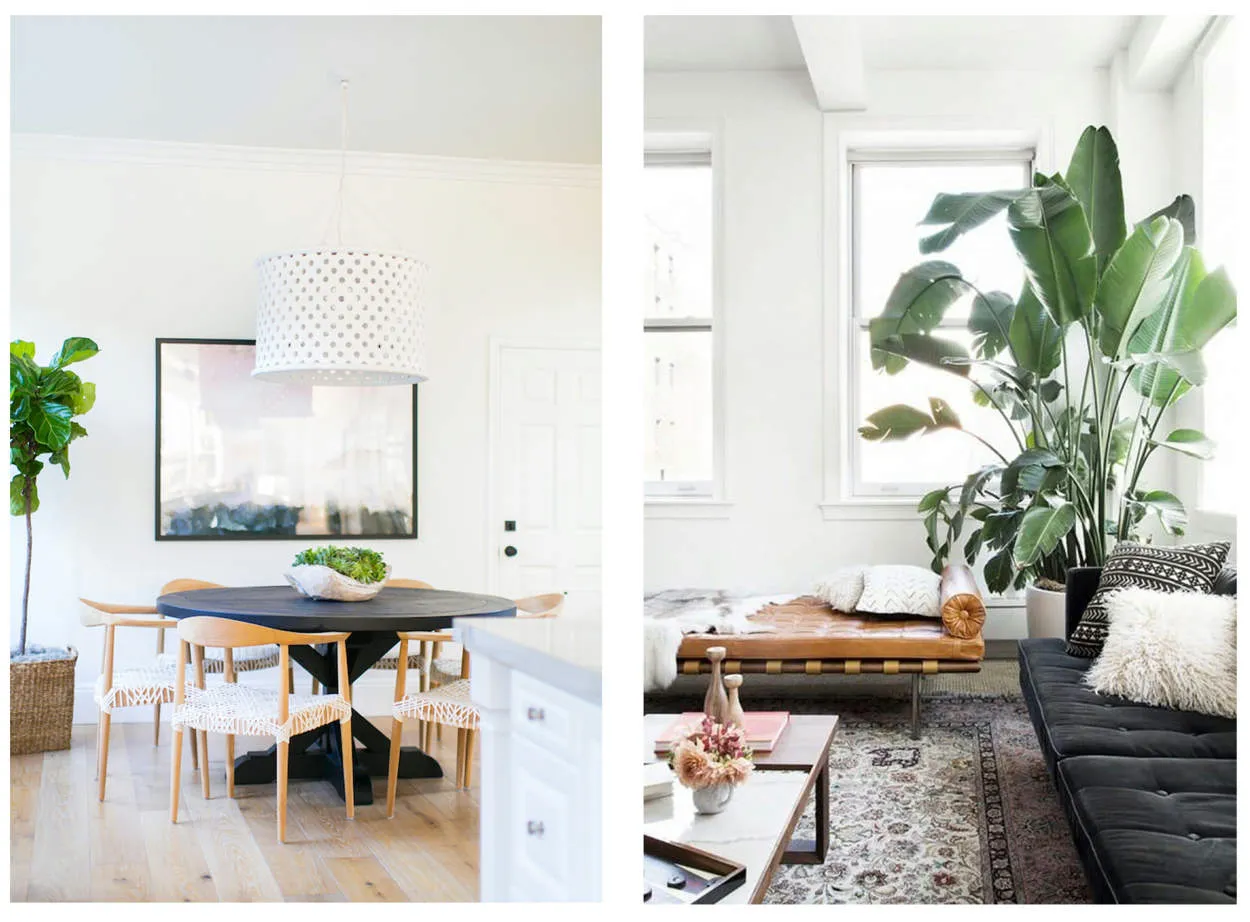Decorating with Plants: Bringing Nature into Your Home
Incorporating Greenery in Interior Design

Adding plants to your interior design can completely transform the look and feel of your home. Not only do they bring a touch of nature indoors, but they also offer numerous benefits for your overall well-being. Here are some creative ways to incorporate greenery into your interior design:
1. Plant-filled shelves
Arrange a variety of plants on shelves to create a visual focal point in any room. Mix different sizes, shapes, and colors of plants to add interest and dimension. This not only adds a natural touch but also serves as a unique decorative element.
2. Hanging planters
Hang planters from the ceiling or mount them on walls to maximize space and create an eye-catching display. Choose trailing plants like pothos or ivy to create a cascading effect, or opt for air plants that require minimal maintenance.
3. Vertical gardens
If you’re short on floor space, consider creating a vertical garden on a wall. This not only adds a green backdrop but also creates a visually appealing and refreshing atmosphere. Utilize wall-mounted planters or vertical trellis systems to achieve this look.
4. Herb garden in the kitchen
Bring nature into your kitchen by growing a small herb garden on your windowsill or countertop. Not only will you have fresh herbs at your fingertips for cooking, but the aroma of these plants will also enhance the overall ambiance.
5. Statement plant
Make a bold statement by incorporating a large, statement plant as a centerpiece in your living room or entryway. Plants like a fiddle-leaf fig or a lush palm can instantly elevate the aesthetics and create a striking focal point.
6. Terrariums
Create mini ecosystems within your home by setting up terrariums. These small glass containers can hold a variety of plants and make for beautiful tabletop or shelf decorations. Succulents and cacti are perfect choices for low-maintenance terrariums.
Incorporating greenery into your interior design not only adds visual appeal but also helps purify the air, reduce stress, and promote a sense of well-being. Experiment with different plants and arrangements to find the perfect balance for your home.
Eco-Friendly Plant Decor Ideas
Incorporating plants into your home decor is not only aesthetically pleasing but also beneficial for the environment. Here are some eco-friendly plant decor ideas to bring nature indoors:
1. Vertical Gardens
Create a stunning focal point by installing a vertical garden. Utilizing walls or hanging planters, this space-saving technique maximizes greenery in your home.
2. Terrariums
Decorate your space with captivating terrariums. These miniature gardens enclosed in glass containers offer a low-maintenance way to enjoy the beauty of plants.
3. Air Purifying Plants
Choose indoor plants that not only add beauty but also purify the air. Spider plants, peace lilies, and pothos are all excellent options known for their air-cleaning properties.
4. Upcycled Planters
Get creative with your planters by repurposing old objects. Upcycling items like teacups, mason jars, or old cans adds a unique and eco-friendly touch to your plant decor.
5. Herb Gardens
Grow your own herbs indoors. Herb gardens not only provide fresh flavors for your cooking but also reduce your reliance on store-bought herbs wrapped in plastic packaging.
6. Hanging Plants
Opt for hanging plants to add visual interest and save space. Macrame hangers or wall-mounted planters are great options to bring greenery to different corners of your home.
7. Sustainable Plant Care
Practice eco-friendly plant care by using organic fertilizers, incorporating rainwater collection, and reusing water from cooking or steaming vegetables to hydrate your plants.
By incorporating these eco-friendly plant decor ideas into your home, you can create a stylish and sustainable living space while bringing a slice of nature indoors.
Choosing Plants for Different Room Conditions
When it comes to decorating your home with plants, it’s essential to consider the specific conditions of each room. Different areas in your home may have varying levels of natural light, humidity, and temperature, which can affect the well-being of the plants you choose. Here are some tips on selecting the right plants for different room conditions:
1. Low-Light Areas
If you have a room with minimal natural light, it’s best to opt for plants that can thrive in low-light conditions. Some suitable options include snake plants (Sansevieria), pothos (Epipremnum aureum), and ZZ plants (Zamioculcas zamiifolia). These plants are known for their ability to survive in low-light environments.
2. Bright and Sunny Rooms
In areas with abundant sunlight, you have more choices in terms of plant selection. Consider plants such as succulents, cacti, and flowering plants like orchids or peace lilies, which thrive in bright and sunny conditions. Just make sure to provide proper sun protection for sensitive plants to prevent leaf burn.
3. Humid Spaces
If you have a humid room, such as a bathroom or kitchen, you can select plants that enjoy higher levels of moisture. Ferns, spider plants (Chlorophytum comosum), and peace lilies (Spathiphyllum) are some great options for these areas. These plants not only tolerate humidity but can even help to purify the air.
4. Dry Environments
In rooms with low humidity, it’s important to choose plants that can withstand dry conditions. Consider plants like aloe vera, succulents, and cacti, as they have adapted to arid environments and require less frequent watering. Adding a humidifier or misting the plants occasionally can also help create a more favorable environment.
By taking into account the different conditions of each room, you can ensure that your plants not only thrive but also enhance the overall aesthetics of your home. Remember to research the specific care requirements of each plant and provide the necessary maintenance to keep them healthy and beautiful.
Creating a Home Botanical Garden
Decorating your home with plants is a wonderful way to bring nature indoors and create a soothing, beautiful environment. One of the most enchanting ways to do this is by creating your own home botanical garden. This article will guide you through the process of setting up and maintaining your very own green oasis.
Choosing the Right Plants
Start by selecting plants that thrive in indoor environments. Consider factors such as light levels, temperature, and humidity. Popular choices for home botanical gardens include succulents, ferns, orchids, and peace lilies.
Creating the Perfect Space
Find an area in your home that receives adequate natural light, such as near a window. If the light is limited, you can also use artificial grow lights to provide the necessary brightness. Ensure that the space is well-ventilated and has enough room for the plants to grow.
Potting and Arranging
Choose aesthetically pleasing pots or containers that complement your home decor. Ensure each plant has proper drainage and use a high-quality potting mix. Experiment with arranging the plants to create visually appealing displays – you can group them by height, color, or texture.
Maintaining Your Botanical Garden
Regularly water your plants, but be careful not to overwater them. Monitor their growth and trim or prune as needed. Provide fertilizer at appropriate intervals and be mindful of any potential pests. Additionally, rotate your plants to ensure they receive equal sunlight.
Enriching Your Home with Nature
A home botanical garden not only adds beauty to your living space but also offers numerous health benefits. Plants can purify the air, reduce stress, and boost your mood. So, surround yourself with nature and create an oasis of calm right in your own home!
The Benefits of Indoor Plants
Indoor plants not only enhance the aesthetics of your home but also offer numerous benefits that go beyond just decorating. Here are some of the advantages of having indoor plants:
1. Improved Air Quality
Plants naturally purify the air by absorbing carbon dioxide and releasing oxygen through photosynthesis. They also remove toxins and pollutants present in the environment, making the air fresher and healthier.
2. Enhanced Mental Well-being
Research has shown that being around plants can have a positive impact on mental health. Indoor plants create a calming and soothing environment, reducing stress, anxiety, and depression. They also improve focus, productivity, and overall cognitive function.
3. Increased Humidity
Plants release moisture through a process called transpiration, which raises the humidity levels in a room. This can be particularly beneficial during dry seasons or in areas with low humidity, as it helps alleviate dry skin, respiratory problems, and even reduces the chance of allergies.
4. Noise Reduction
Indoor plants can act as natural sound absorbers by reducing background noise. Their leaves and branches absorb, diffract, and reflect sound waves, creating a quieter and more peaceful atmosphere.
5. Improved Focus and Productivity
Studies have indicated that the presence of plants in indoor spaces can enhance focus, concentration, and overall productivity. Being in a green environment boosts attention span and reduces mental fatigue and boredom.
6. Speedy Recovery
Having plants in hospitals or at home can contribute to a faster recovery from illnesses or surgeries. Natural elements help create a positive and healing atmosphere, reducing stress levels and promoting well-being.
7. Increased Creativity
Surrounding yourself with indoor plants can stimulate creativity and improve problem-solving skills. The greenery and connection with nature inspire innovative thinking and a fresh perspective.
With these incredible benefits, incorporating indoor plants into your home decor is a simple and effective way to create a healthier, happier, and more harmonious living space.
Plant Care and Maintenance Tips
In this article, we will explore essential tips for plant care and maintenance, which will help you bring nature into your home effortlessly.
1. Choose the Right Plants
Before starting your plant decoration journey, consider the lighting and space available in your home. Select plants that thrive in the specific conditions of each room. Some plants require direct sunlight, while others prefer shade.
2. Watering Guidelines
Proper watering is crucial for plant health. Research the specific watering needs of each plant and create a watering schedule to avoid over or under-watering. Remember, different plants have different water requirements.
3. Provide Adequate Light
Plants need light to carry out photosynthesis. Ensure that your plants are placed in areas with sufficient natural light. If natural light is limited, consider using artificial grow lights to support their growth.
4. Proper Soil and Fertilization
Choose the right soil for your plants, as this will provide essential nutrients. Additionally, regular fertilization will help enhance plant growth. Use organic fertilizers and follow recommended application instructions.
5. Pruning and Trimming
Maintain the shape and size of your plants by pruning and trimming them regularly. Remove dead leaves and branches to promote healthy growth and prevent disease spreading.
6. Protect from Pests
Monitor your plants for any signs of pests or diseases. Act quickly to prevent infestations by regularly inspecting the leaves and using appropriate insecticides or natural remedies.
7. Rotate and Reposition
Rotate your plants periodically to ensure even growth and prevent them from leaning towards the light source. Repositioning the plants not only promotes healthy growth but also gives your home a fresh look.
In conclusion, by following these plant care and maintenance tips, you can successfully decorate your home with plants and create a calming and beautiful natural environment. Remember to research each plant’s specific needs and adapt your care routine accordingly. Enjoy the benefits of nature indoors!
Conclusion
Incorporating plants into your home decor is a fantastic way to bring nature indoors and create a peaceful and refreshing atmosphere. Not only do plants add beauty and style to your living space, but they also improve air quality and offer numerous health benefits. Whether you choose to display small succulents, vibrant flowers, or stunning foliage plants, the presence of greenery will undoubtedly enhance the overall ambiance of your home. So go ahead and embrace the power of plants in decorating your space!



